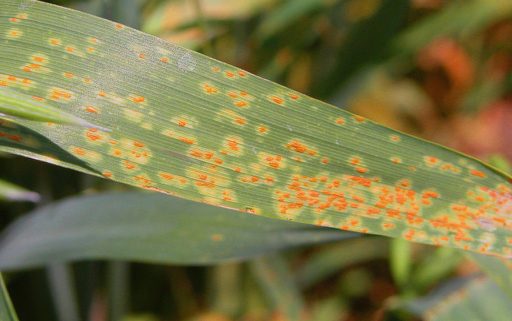Should I Be Applying Fungicide to My Fall Forage Oat Crop?
Damon Smith, Extension Field Crops Pathologist, Department of Plant Pathology, University of Wisconsin-Madison
Shawn Conley, Extension Soybean and Small Grains Agronomist, Department of Agronomy, University of Wisconsin-Madison
Record prevent-plant acres and lack of on-farm forage has pushed WI farmers into trying alternative cropping systems in 2019. A record number of late planted oats have been planted with the intension of being used as a forage. Oats, planted the first week of August can be expected to produce 2.5 to 3 t DM/a in an average year. Coblentz, USDA Dairy Forage Research Center, found that a late-maturing forage cultivar (ForagePlus) produced maximum annual yields ranging from 2 to 3.5 t DM/a. Because the forage cultivar matured slowly it was better able to respond to sometimes erratic late-summer precipitation. These oat types mature later and produce more tonnage of quality forage. In addition, fall planted oat is higher in forage quality than spring planted oats. Research at the University of Wisconsin by Albrecht found that maturation of summer-sown (August) oats was delayed, resulting in 10 to 15% less neutral detergent fiber (NDF), 18% greater digestibility, and 250% more water soluble carbohydrate than spring-sown oat. With all of the cool wet weather in 2019 and lush plant tissue, these oats are likely to be challenged with crown rust. The question being posed today is should farmers be spraying these fall forage oats with a fungicide?
We are being up front here…we don’t have any empirical data to speak from so this our best educated GEUSTIMATE. The oat crown rust pathogen (Puccinia coronataf. sp. avenae) can quickly overcome genetic resistance in oat grain varieties. That means that certain varieties have better partial resistance than others, which can result in differences in yield and quality parameters in years when crown rust is significant. Examples of these differences can be found below:
- Response of Four Oat Varieties to a Plant Growth Regulator and Foliar Fungicide Combination in 2019
- Agronomic Management and Fungicide Effects on Oat Yield and Quality in Wisconsin
It is important to know the level of resistance to crown rust that your variety has. This might dictate how often you scout in order to make your fungicide spray decision.
When it comes to fungicide efficacy, many products are very effective against oat crown rust. Haugen et al. at North Dakota State University conducted fungicide evaluations on oat for grain in 2014-2016. In all years fungicide was applied at flag leaf emergence. Products used included Headline®, Priaxor®, Tilt®, and Quadris®. In the 2015 and 2016 data, normalized difference vegetation index (NDVI) was recorded to measure quality of the vegetative portions of the plant. In all cases fungicide improved the NDVI scores relative to the control. Not surprisingly, a corresponding increase in yield was observed relative to the higher NDVI scores in the fungicide-treated oats. While these data are from oats for grain, it highlights the fact that fungicide can indeed protect oat plants from crown rust and delay disease development, resulting in greener, healthier vegetative plant parts.
When making the decision to apply fungicide on oats for forage, it appears that there are several products which are effective for controlling crown rust. Given the current farm economy, it might be good to find a product that is cheap, yet effective, to keep the cost of this input low. Several of the strobilurin only fungicides are labeled for control of rust in oats for forage. These include Headline® and Quadris®. Others might be available, however, read the labels very carefully. Be sure that oats for forage or hay is indicated on the label. Also be sure you know what the pre-harvest interval (PHI) is for the product you choose. Some of these products cannot be harvested for 7, 14, or more days after application for forage. Additional fungicide options may be found in A3646, Pest management in Wisconsin Field Crops. Again, read any labels VERY carefully to be sure that the product can be used for oats for hay and forage.
Given the upward limitations of forage yield ~2 to 3.5 t DM/a it is difficult to know what dry matter differences we can expect; however, the most likely benefit of a fungicide application on forage oats would be in forage quality. Given the market prices and lack of cash flow in agriculture right now if a grower chose to do this practice a lower cost product that was efficacious on the oat crown rust would be the best choice.
Author Note: Mention of product names above is not an endorsement for that product.






